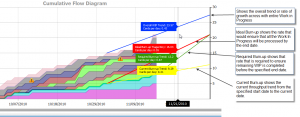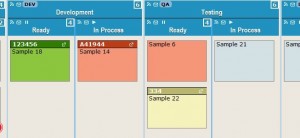
Over the weekend we added a couple of new features to Planview AgilePlace’s online kanban system, based on requests from our customers.
Cumulative Flow Diagram Enhancements
We’ve added a couple of nice new features to the Cumulative Flow Diagram. Now you can filter the CFD by Card Type or Class of Service, by clicking on the tabs at the top, and selecting which kinds of items you want included in the diagram.


Calculating Burn-up Trajectory
The burn-up trajectory is a feature that when added to the Cumulative Flow Diagrams is designed to provide useful insight into the progress of the team against the outstanding Work In Progress. The burn-up trajectory is calculated based on a selected time period and demonstrates the following trends:
- Current Burn-up Trend – This trend represents the current throughput of team within the selected time period. The trend shows the slope of Cards processed into the selected Done lane from the selected start date up to the current date. This trend is then projected out to the selected end date to show the number of Cards that would be processed based on the current throughout.
- Ideal Burn-up Trend – This trend represents the required slope necessary to process all the Work In Process up to the selected Burn-up Lane (end lane) for the specified time frame. This slope shows you what your throughput should be in order to complete the work in process.
- Required Burn-up Trend – This trend demonstrates the throughput that is required to burn through the remaining Work In Process from the current date up to the specified end date.
- Overall WIP Trend – This trend lets you know the rate of growth across your entire Work In Process. You can compare the slope of this line against the slope of the Current Burn-up Trend. This will tell you if your overall WIP is increasing, in other words, is the amount of work entering the system greater than the amount of work being completed by the system

Using these trend lines, teams can get an good understanding of how quickly they are processing work and whether the current velocity is sufficient to process the work within a system over a given time frame. The information presented also informs teams of what rate is required to complete the remaining work from the current date.
External Card Id
For those of you who track bugs or tickets in some other external system, like JIRA, Bugzilla, or others, and use Planview AgilePlace to visualize the work, we’ve provided a way for you to easily link the Kanban cards back to items in your other tracking system. If you enable the External Card Id settings for a board, you can easily enter the id of the item in the tracking system, and Planview AgilePlace will provide a convenient link back to the system for you.


We also added a couple of new API methods that allow you to retrieve cards by their “external id”.
![En global plan för hantering av samarbetsarbete [Video]](https://blog.planview.com/se/wp-content/uploads/2019/07/A-Global-Collaborative-Work-management-blueprint.png)



